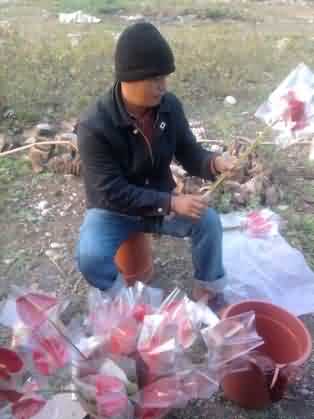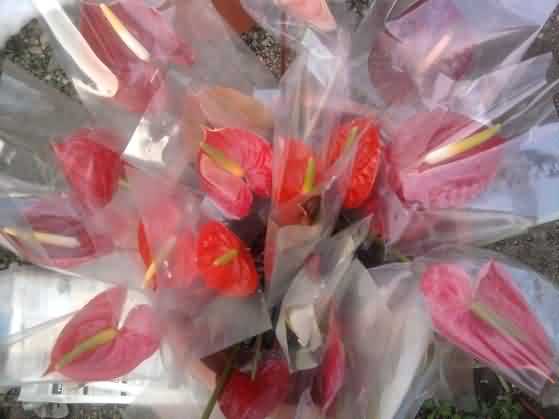एन्थूरीअम कट पुुुुष्पों का कटाई उपरांत प्रबंधन
 Anthurium (Anthurium andreanum) is an evergreen, tropical, perennial herbaceous plant grown for showy cut flowers valued for colorful, long lasting, cylindrical spadix subtended in large heart shaped spathe and unusually attractive foliage.
Anthurium (Anthurium andreanum) is an evergreen, tropical, perennial herbaceous plant grown for showy cut flowers valued for colorful, long lasting, cylindrical spadix subtended in large heart shaped spathe and unusually attractive foliage.
Anthurium, commonly called as Flamingo flower or Flamingo lily, is ideal for beds, borders, pots and suites very well for floral arrangements. The spathe and spadix are brilliantly colored ranging from scarlet, red, salmon, orange, pink and white but red is the most preferred colour.
Anthurium cut flowers are highly perishable, prone to post-harvest losses and necessitate utmost care. Anthurium cut flowers survive without much deterioration for about two weeks by nature.
However, quality of cut flowers depends on stage of harvest, pre-harvest factors and post-harvest handling. Post harvest management involves the steps for the improvement in keeping quality of the flower to the consumer.
Factors affecting the post-harvest quality are pre-harvest factors viz. genetical, environmental (temperature, relative humidity, light), nutrition, irrigation and other cultural practices contribute to 70 per cent and remaining 30 per cent is determined through the post harvest management viz. stage, time and method of harvest, pre-cooling, bunching, packaging, storage and use of floral preservatives.
Pre-requisites for post-harvest quality of anthurium cut flower
- The size, shape, colour and texture of the spathe
- A heart shaped symmetrical spathe with overlapping or fused lobes
- While packing, the spadix should be shorter than spathe and reclined artistically and gently
- The spathe should be free from any kind of damage and infestation
- Straight and sturdy flower stems with shorter internodes
Pre-Harvest Factors
The spathe of anthurium is tender and subject to bruising and colour fading due to handling and calcium deficiency. Also, high nitrogenous fertilizer reduces and moderate to high potassium levels improve post harvest life. Apart from environmental, nutrition and cultural factors, the most important aspect is selection of variety which determines the future of the produce. There are three types of anthurium flowers, namely standard, obake and tulip. The most common type is standard varies in size 12x11 cm to 20x18 cm, heart shaped, spathe lobes often overlap. Obake types are bicolour, popular for their two tone colouration. The tulip types have medium size cupped spathe with a straight and erect spadix.
Anthurium variety must have
- Compact plants with short inter nodes producing suckers profusely
- Bright coloured, showy, heart shaped spathe with plenty of blisters and symmetrical overlapping of basal lobes
- Spadix shorter in length than spathe, reclining to the spathe on an angle of less than 300
- Erect, long flower stem about five times the length of the spathe
- Resistant to common diseases and pests
Stage of Harvest of Anthurium
Anthurium blooms throughout the year. The flowers are harvested when spadix is almost fully developed and cut preferably in the morning. The best stage of harvesting flowers is one-third to two-third of the true flowers on the spadix open. Flowers are cut with sharp knife/secateurs leaving 3 cm on the mother plant to prevent basal rotting. The flowers should be placed immediately in water after cutting.
Pre-Cooling of Anthurium
Anthurium is stored in water at 13° C for 3-5 weeks. Flowers are very sensitive to low temperature. Storage below 13° C causes darkening of spathe. Red coloured cultivars are more susceptible to chilling injury.
Pulsing of Anthurium
Pulsing with 100 ppm silver Nitrate for 45 minutes maintain water uptake and respiration. Before transportation, pulsing with 25 ppm Silver Nitrate for 10 minutes or Benzyl Adenine (BA) at 150 ppm for 8 hours improves the vase life of cut flowers.
Grading Anthurium flowers
Anthurium flowers are graded on the basis of the size of their spathe. The minimum spathe size should be 3-9 cm with stem length of 30 cm. Hawiian cultivars have four grades namely extra, fancy, choice and standard. The spathe size (L+W/2) may be specified with conjunction to the grade as miniature (less than 7.5 cm), small (9.5-10 cm), large (12.5-15 cm) and extra large (more than 15 cm).
Packaging of Anthurium flowers
Flowers are packed in corrugated cardboard boxes. The box is lined with polythene sheets and layers of newspaper. 120 Nos. of cut anthurium are packed in a 102x43x29 cm box with their spathe face down and their stem interwoven. Moist shredded newspaper is inserted to provide cushion and maintains humidity. Covering each flower with waxed tissue or polyethylene envelop to reduce mechanical damage, before packing is also practised.


Packaging of cut flowers Packaged anthurium cut flowers
Storage
The temperature during storage greatly determines the postharvest life of flowers. High temperature in storage declines the vase life of flower due to high rates of transpiration and respiration, whereas, low temperature is subjected to chilling injury. Therefore, optimum storage temperature for anthurium cut flowers should be 13° C.
Maintenance of Cool Chain
It is important to maintain the cool chain while transporting the flowers. Reefer vans should be preferred for transportation. In the absence of reefer van, ice can be used to bring down the temperature in the box. Overall pre-cooling of flowers and maintaining the cool chain with appropriate packing will help in realizing better price for the flowers in the market.
Vase life
Anthuriums survive without much deterioration for about two weeks by nature. Commercial floral preservative viz. floralife, everbloom and roselife increases vase life 2-3 times in compare to normal condition. Waxing and use of anti-transpirants on the spathe also improves longevity of cut flowers.
PHYSIOLOGICAL DISORDERS
Flower abortion, flower deformation and rosette formation:
Flower on spadix aborts, growth of the spathe is stunted and stem of the flower is short. This disorder is mainly genetic dependent, but can be prevented by restricting root pressure, promoting plant activity, reduction in temperature, rapid ventilation, cooling and humidification systems. Excessive root pressure can be restricted by reducing irrigation and raising EC of the media.
Cracks:
This disorder often occurs at the margin of the spathe during active growth period with temporarily higher relative humidity. Lower humidity during the night is best possible remedy to reduce cracks.
Folder Ears:
The basal lobe of the flowers is not fully unfolded during the early stage. This disorder is variety dependent. There is no known remedy.
Sticking:
In this case, flower does not open because the spathe is stuck. Sticking is variety dependent and occurs specially during rapid growth period. Lower relative humidity is best possible remedy to reduce sticking. Loosening of the flowers by hand at early stage can also minimise this disorder.
Jamming:
Jamming is strong variety dependent characteristics that more frequently occurs under arid conditions. The flowers jams in the sheath, since, the leaves is wound too tightly around the flower. Such disorder occurs more frequently in cultivars with long sheaths. Keeping the growing media relatively moist is the best remedy.

Packaged Anthurium flowers in boxes
Authors:
KRISHNA S. TOMAR
College of Horticulture & Forestry, Central Agricultural University,
Pasighat – 791 102 (Arunachal Pradesh)
E-mail:
